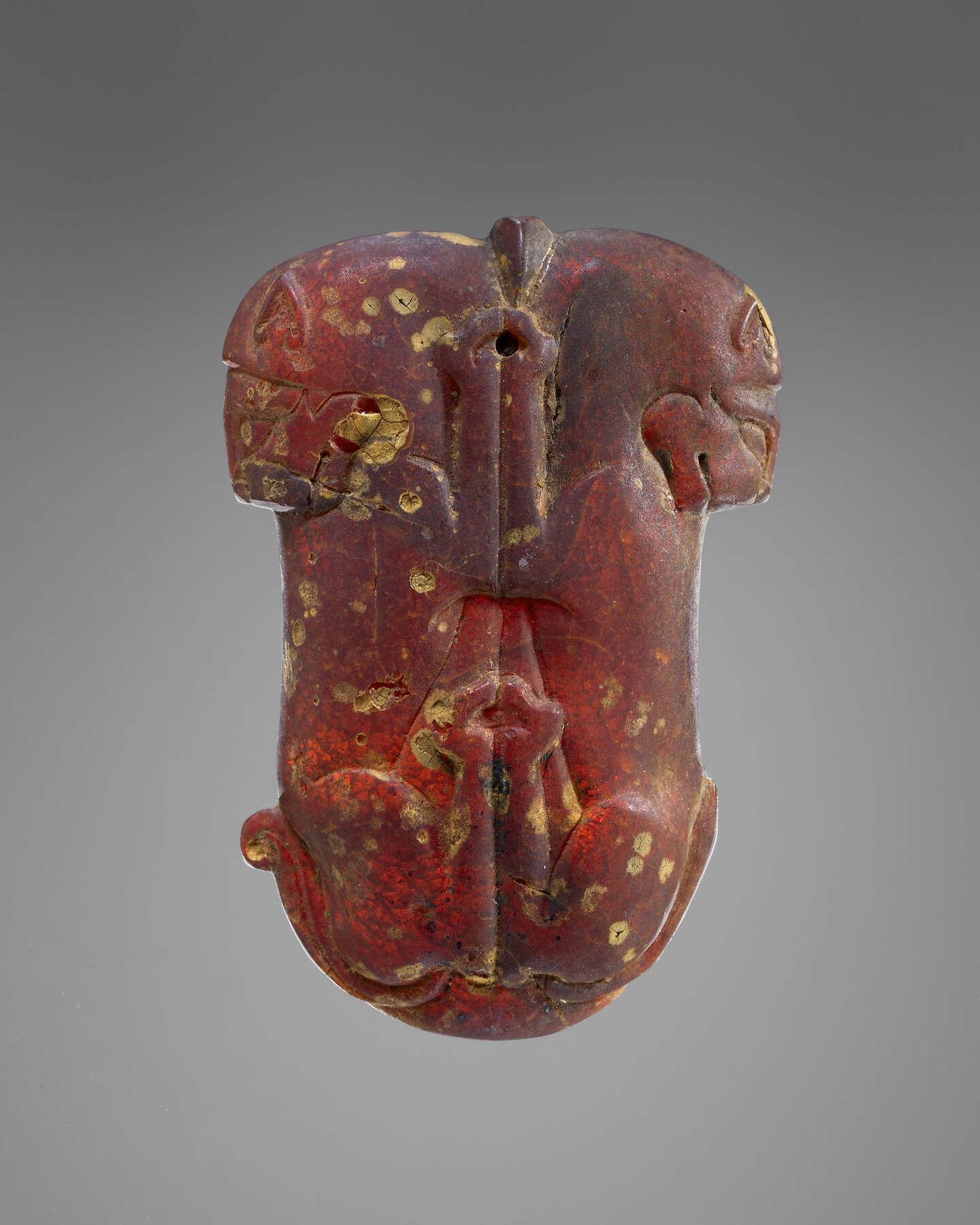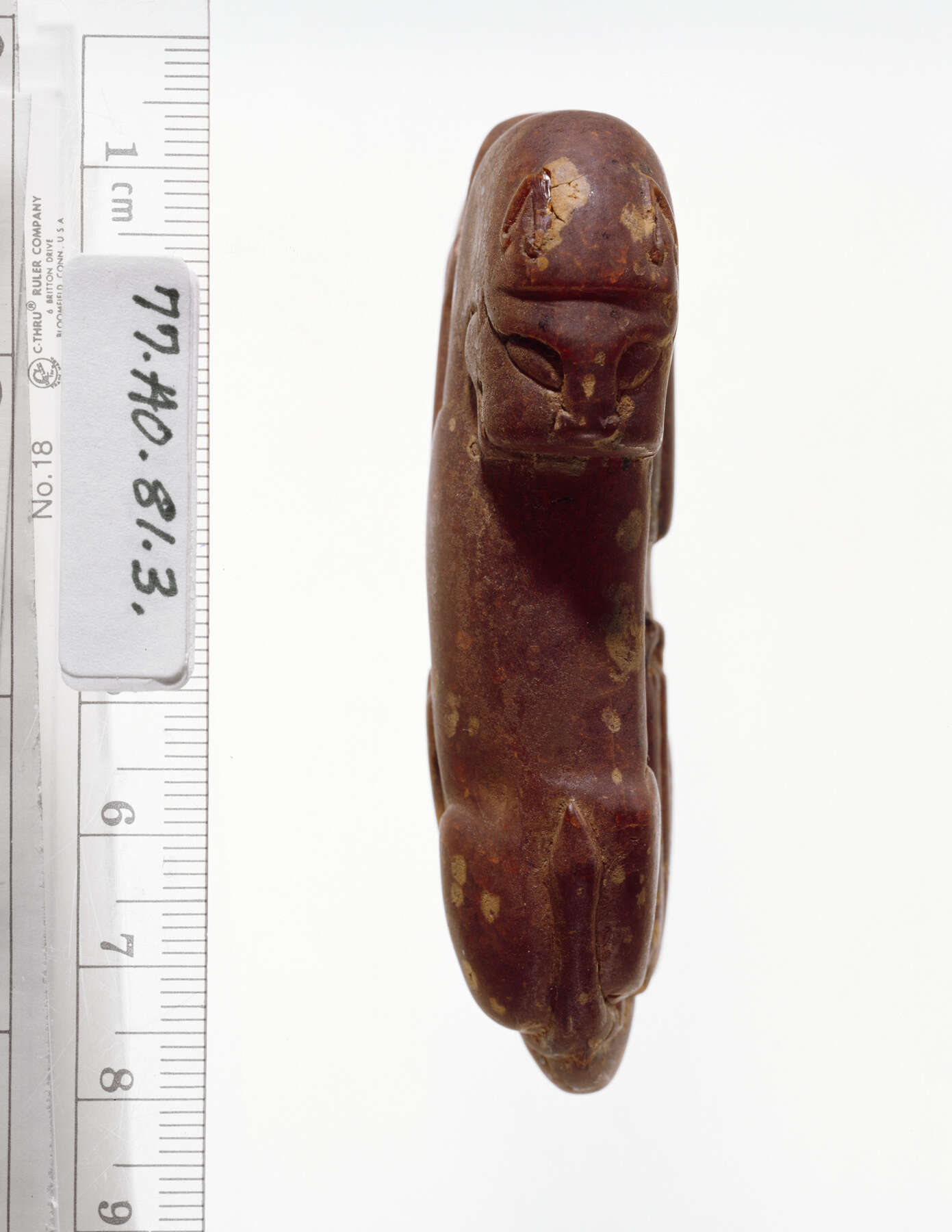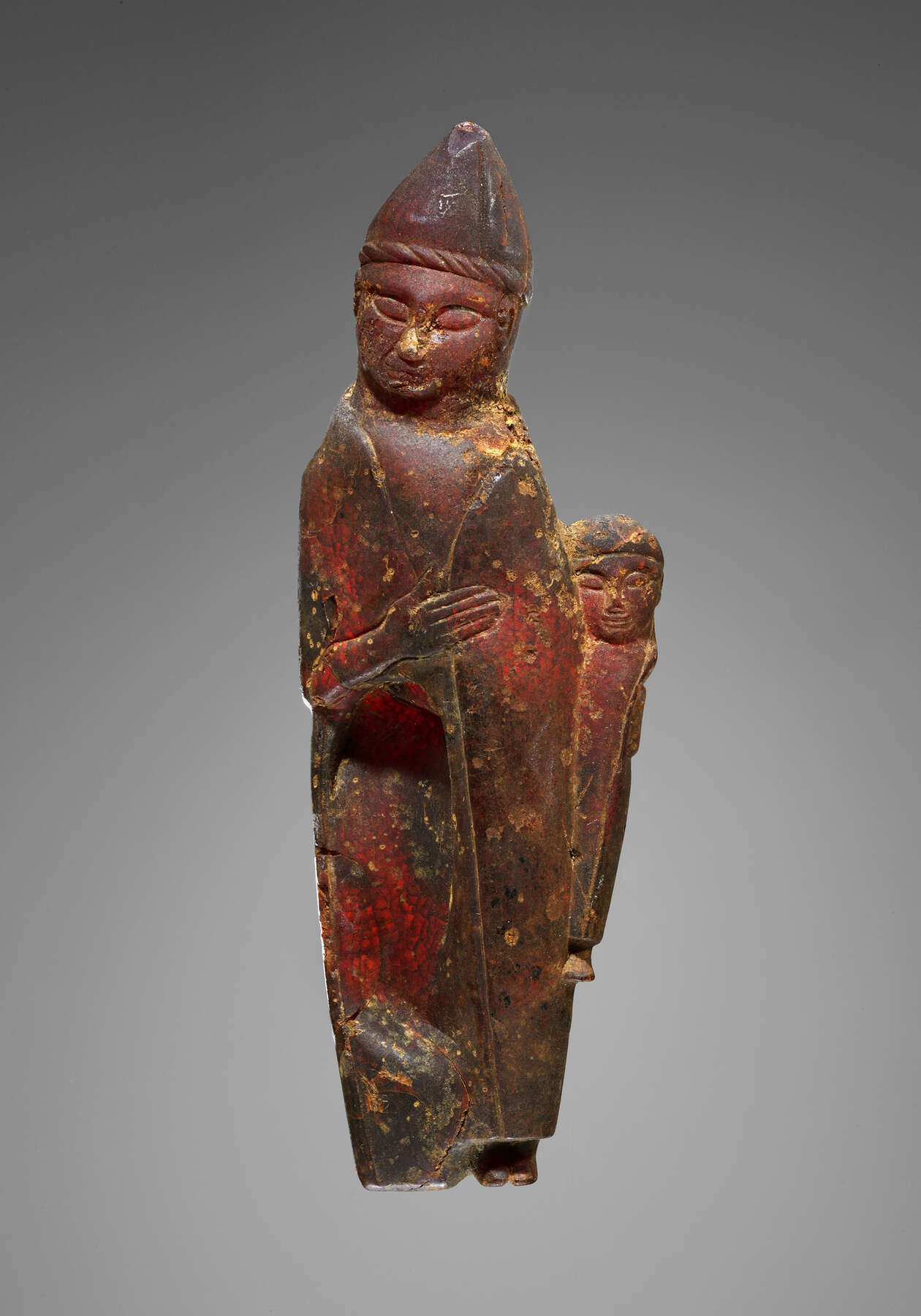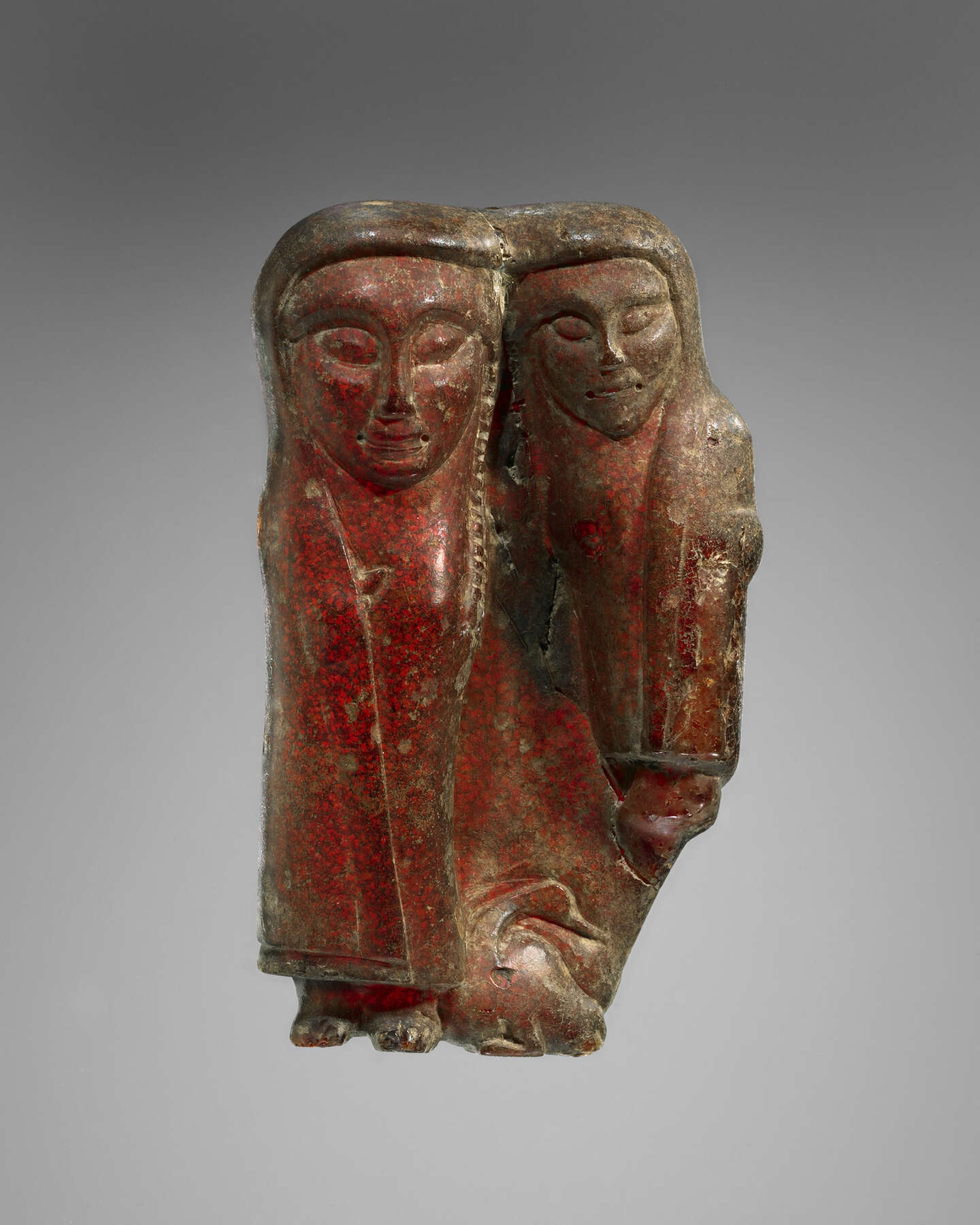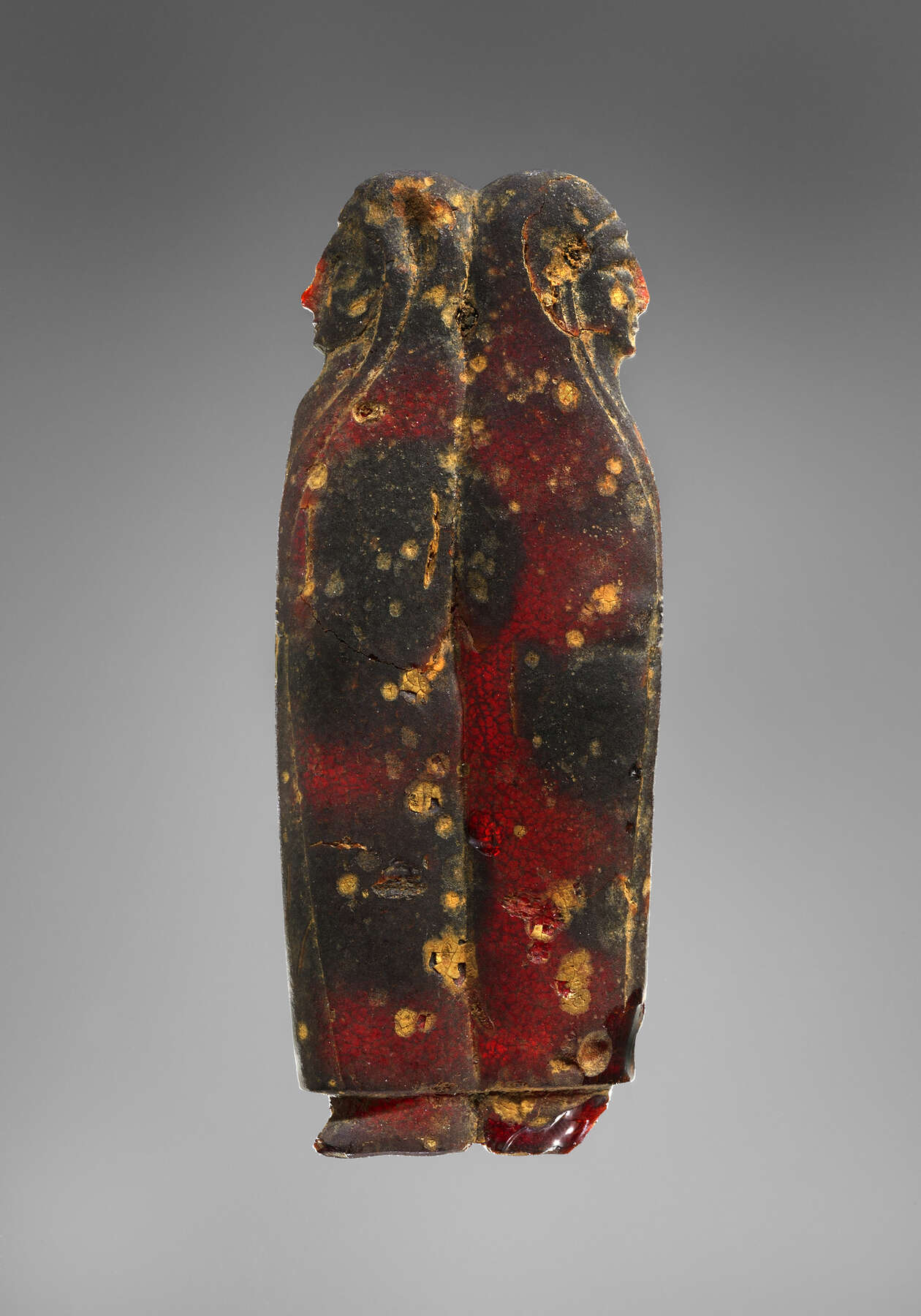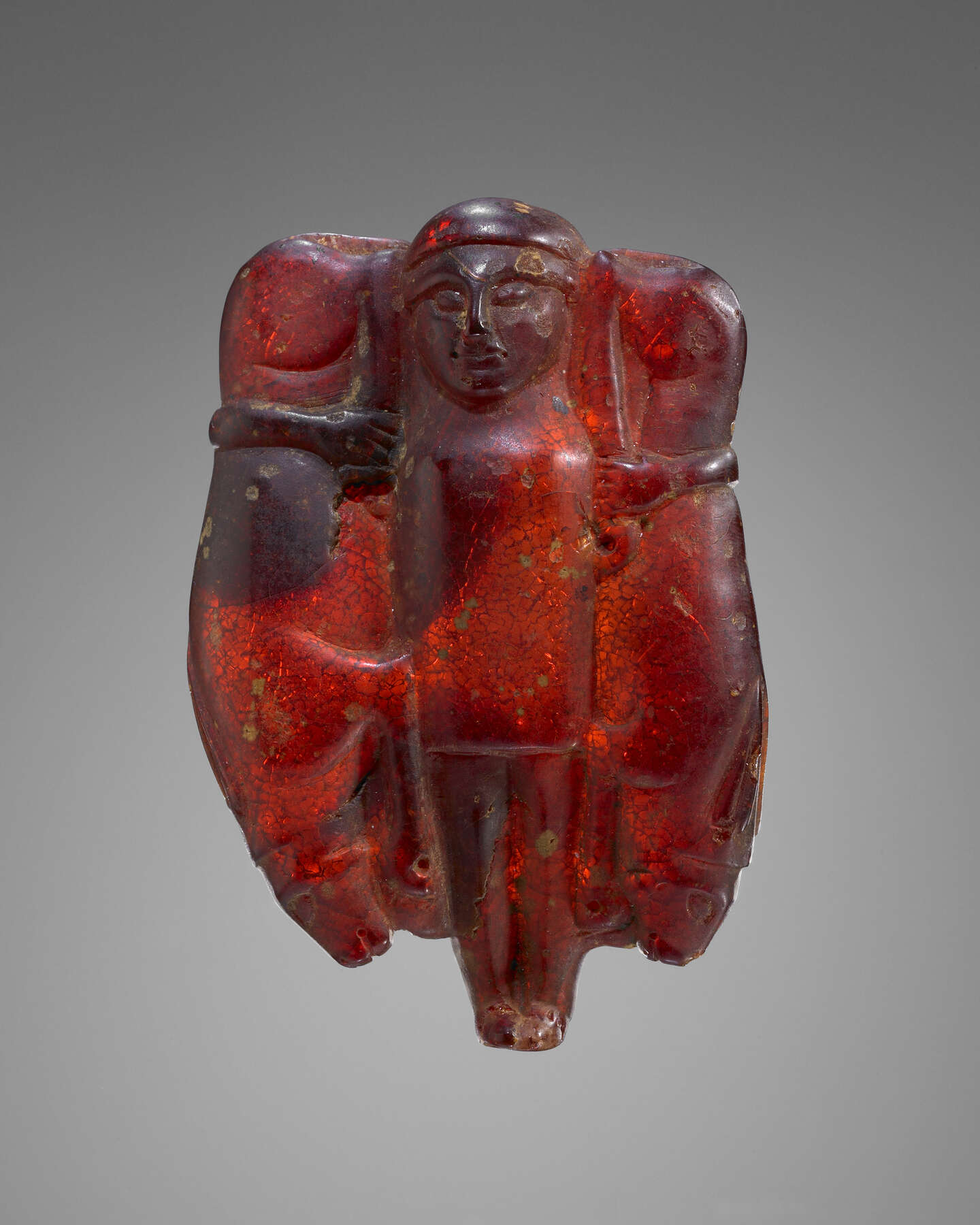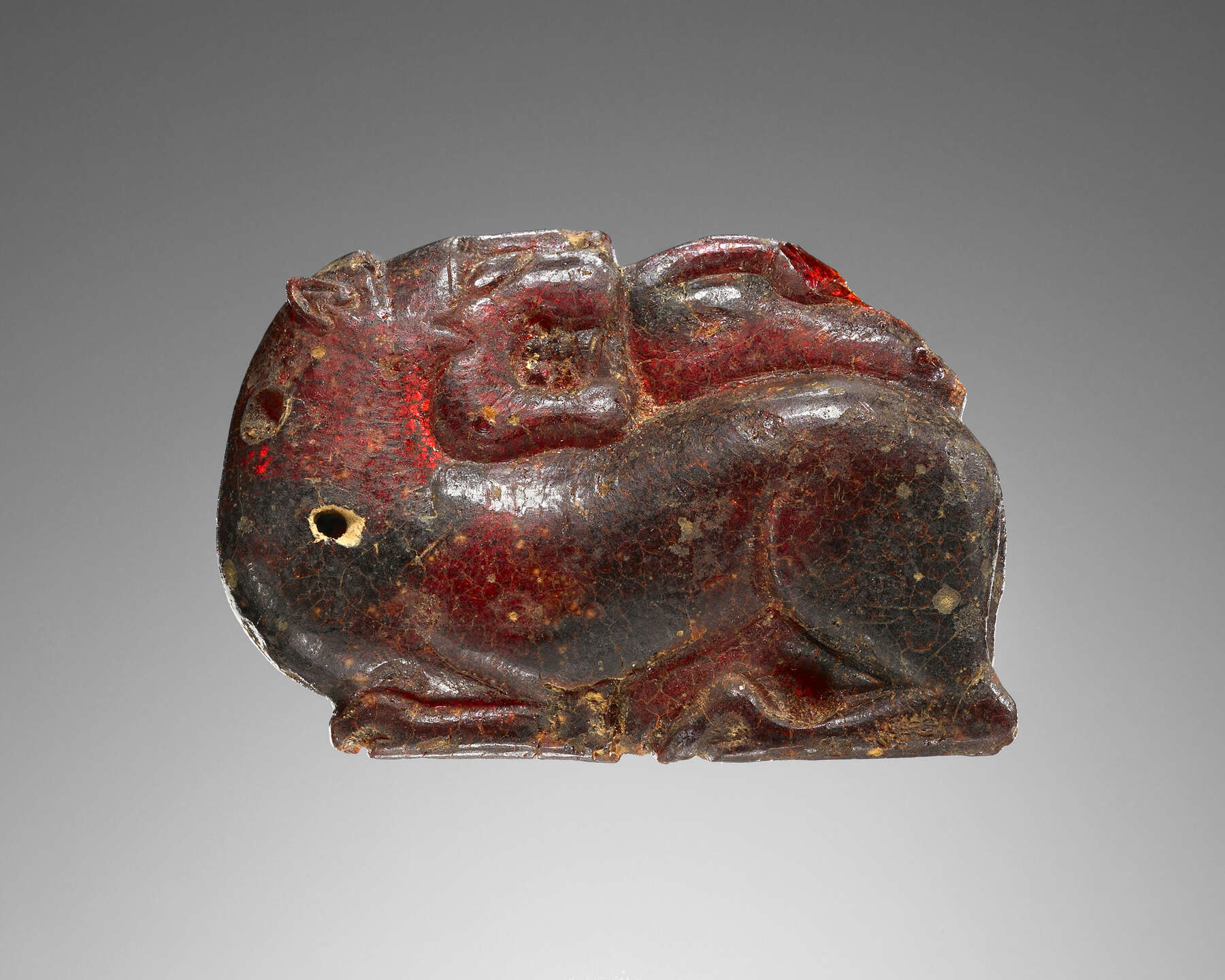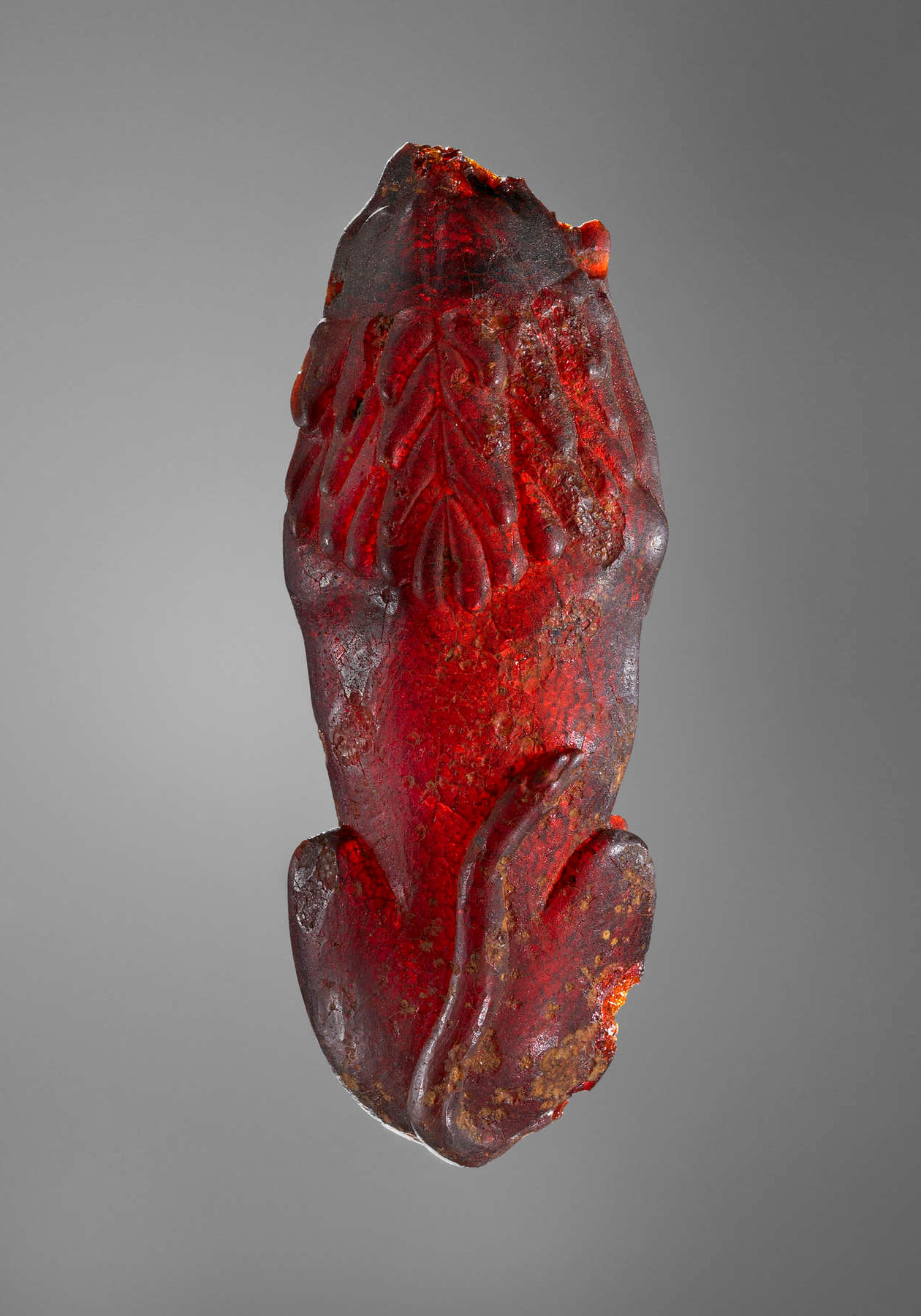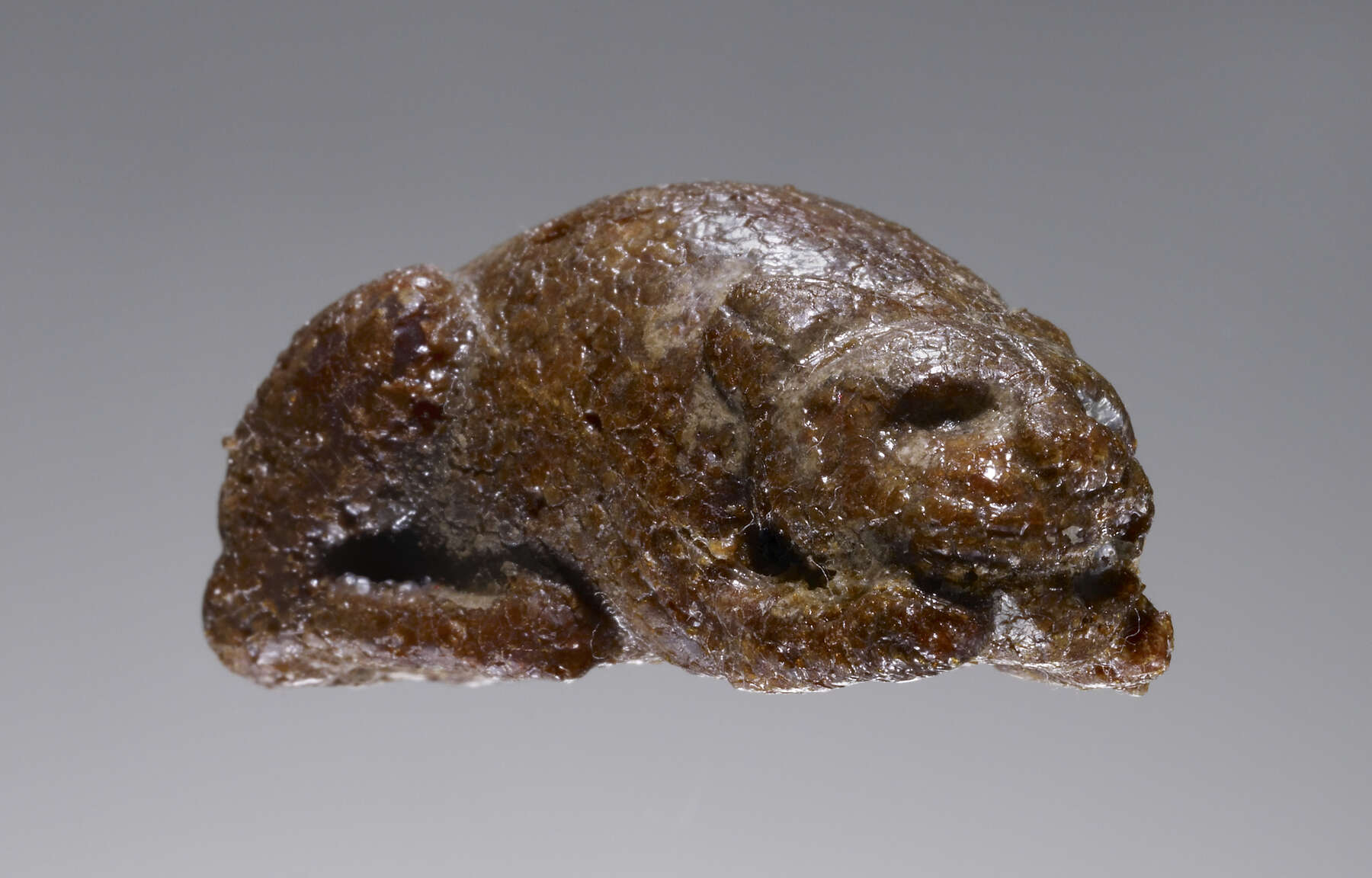6. Pendant: Paired Lions
| Accession Number | 77.AO.81.3 |
| Culture | Etruscan |
| Date | 600–550 B.C. |
| Dimensions | Height: 56 mm; width: 82 mm; depth: 20 mm; Diameter of perforation holes: 2 mm; Weight: 54.4 g |
| Subjects | Egypt; Lion |
Provenance
–1977, Gordon McLendon (Dallas, TX), donated to the J. Paul Getty Museum, 1977.
Condition
The pendant is in a good state of preservation. The surface is firm and stable, although it is laced with many cracks and has overall crazing and pitting. In ambient light, the piece is translucent and dark brownish black; in transmitted light, it is translucent and orange. There are some small fissures but no visible inclusions. Before entering the Getty Museum, the pendant is reported to have been mechanically cleaned.
Description
Although the two sides of the pendant are nearly identical, the side with fewer natural flaws is here designated the obverse. The pendant is composed of two compactly designed reguardant lions in repose that are book-matched along their ventral surfaces. At the top, functioning as a suspension device between the two felines, is a protrusion of amber. At the bottom is a section of amber that, together with the encircling tails, forms a calyxlike base.
On the reverse are two crevices, a deep, polished groove extending from the chest to the flank and a smaller indentation near the knee, both resulting from the removal of a fissure or inclusions before the pendant was figured. Other traces of manufacture—the engraved lines, scraped areas, and multidirectional abrasion marks—can be seen around the muzzles, haunches, and legs, and near the base of the tails. A drill was used for the interstices between the pads and toes of the lions’ feet and at the corners of their mouths. The pendant has a triangular set of suspension perforations, each 2 mm in diameter. One extends laterally between the forepaws and intersects with two others, each of which goes from the top of the pendant (in the middle of the flange) to an exit of the lateral bore. When strung, the pendant would have hung with the lions’ heads at the top.
Discussion
There is no exact parallel for this pendant. 77.AO.81.3 belongs to the same Getty group as (cat. no. 1), (cat. no. 2), (cat. no. 3), (cat. no. 4), and (cat. no. 5). The lions of 77.AO.81.3 are nearly identical with the lion of and to a pair of amber lions’ heads in the Louvre.1 They are also generally related in style to the hares of . As is discussed in the entry for Addorsed Females (), there are also few other contemporary amber objects of doubled subjects with which to compare the two pendants. The only other amber of doubled lions is the (possibly) early-fifth-century B.C. fibula decoration from Belmonte Piceno, which represents the foreparts of two lions.2 In 77.AO.81.3, the lions are ventrally positioned, or heraldically posed (rather than addorsed).
The pendant is drilled for suspension so that the lions’ flanks would be presented. This is also the case with the other double-subject amber pendants, the twinned animal and human figures from Tomb VI at Satricum in the Villa Giulia,3 the double lion with single face pendant from Pianello di Castelbellino in Ancona,4 and the two-figure pendant in Philadelphia, perhaps from Ascoli Piceno.5 In every case, as P. G. Warden pointed out, the pose “emphasizes the frontality of the figures and the possibly apotropaic nature of pendants of this sort.”6
The two lions of 77.AO.81.3 appear to be identical, but they are not. The differences are minimal and may offer an opportunity to “see” something of the hand of the carver. The ease with which right profiles are worked (in contrast to the left ones) suggests that the carver was right-handed. The most notable difference between the two lions is the tips of their tails: one is curled back and terminates in a volute (obverse left), and the other is spear-shaped. On both obverse and reverse, the right-hand profiles of the lions are more carefully defined, with rounder mandibles and the heads slanted slightly upward; the left-hand profiles are squarer, with more angular mandibles and the heads carved parallel to the ventral line. Overall, the form of the pendant, especially with the calyxlike form of the tails at the bottom, is reminiscent of a pommel, and although no close analogue exists, it may indicate the experience of the carver or point to a specific model in another hard material: ivory, bone, wood, antler, or horn.
The pairing and style of the lions of 77.AO.81.3 is comparable to that of the pairs of lions held by a Potnia Theron on two types of bucchero kyathos handles found at Poggio Civitate and other northern internal Etruscan sites,7 and on a bucchero infundibulum.8 The schema is unusual because the divinity holds the confronted animals in front of her body. The similarity between the bucchero decorations and 77.AO.81.3 may be taken as additional evidence for locating the manufacture of the Getty Orientalizing ambers to northern internal Etruria.
Although the subject of two confronted lions is age-old, they are not usually presented in a crouching position or with the bodies joined heraldically. This may be a function of fitting the lions into the amber blank’s original form, a challenge perhaps similar to that of squeezing them into a frontal composition for the handle of a bucchero kyathos. The antithetical compositional type, one especially popular for upright lions, has ancient roots in the Near East. The confronted-lion compositions employed in the Aegean Bronze Age and in Orientalizing Greece are related to Hittite types.9 The composition bears remarkable similarity to the confronted lions of the Hittite Dagger God relief carving in chamber B at Yazilikaya.10
The composition of the doubled lions may have had a special set of functions, focusing or going beyond the meaning of the single-lion subject. The doubling may signify two lions, or it may represent repetition, a basic tool of magic. Repetition is an age-old formula for increasing the potency of any amulet, spell, or curse. Another way to read the imagery of the pendant is as an extract of the Potnia Theron schema, such as the pairs adorning the handles of the bucchero kyathoi. On these bucchero cups, the lions announce the presence of the divinity.11 The divine and solar aspects of the amber may have automatically called up the presence of a divinity at the same time that the material underlined the meaning of the lions.
A lion image is one of the oldest of all signs. Considering the importance of the lion as a subject of Egyptian amulets, the most widely dispersed in the circum-Mediterranean world, 77.AO.81.3 likely embeds something of earlier amuletic symbolism, the Egyptian and Near Eastern particularly. In Egypt, the lion was a solar animal and a protective sentinel, a powerful symbol of defense.12 As a desert dweller, the lion was believed to have regenerative powers. From early times there, a double-lion deity, Aker, the lions of yesterday and tomorrow, guarded the sun’s passage through both ends of the day and protected the horizon.13
Notes
- . ↩
- See cat. no. 5, n. 14. ↩
- For the Satricum Tomb VI material, see . ↩
- Ancona, Museo Archeologico Nazionale 4427 (from Pianello di Castelbellino): , pp. 51–52, no. 37, pl. XX. ↩
- Philadelphia, University of Pennsylvania Museum of Archaeology and Anthropology MS 2538: , no. 2, figs. 13.4–6; and , p. 226, no. 241. ↩
- , p. 139. ↩
- , pp. 38–40, nos. 22–23, figs. 13–14.1, pls. 6–7 (his type 1), with reference to . For the related bucchero at the J. Paul Getty Museum, see , United States of America, fasc. 31, The J. Paul Getty Museum, Malibu, fasc. 6 (Malibu, 1996), pp. 17–20, pls. 305.4, 306.4, and 308.1. ↩
- Florence, Museo Archeologico Nazionale 72733: , p. 428, pl. XI, no. 67. ↩
- See the excellent survey of the subject in , pp. 63–65. ↩
- A. A. Yener, “Swords, Armor, and Figurines: A Metalliferous View from the Central Taurus,” electronic version of article in Biblical Archaeologist 58, no. 2 (1995): http://oi.uchicago.edu/research/projects/gol/ba95.html. Yener refers to S. Kosak, Hittite Inventory Texts (CTH 24150) (Heidelberg, 1982). ↩
- For the concept, see Nagy 1994 (in n. 3 in the “Orientalizing Group” section) in relation to a group of terracottas from Cerveteri. ↩
- , p. 69. For additional discussion of lion symbolism, see , (cat. no. 31), and (cat. no. 32). ↩
- , p. 159. ↩
Bibliography
- Berkin 2003
- Berkin, J. M. The Orientalizing Bucchero from the Lower Building at Poggio Civitate (Murlo). Philadelphia, 2003.
- Marangou 1969
- Marangou, L. Lakonische Elfenbein- und Beinschnitzereien. Tübingen, 1969.
- Metzger 1991
- Metzger, C. “Noeud d’Héraclès et torsades: Trois bijoux hellénistiques.” Revue du Louvre 41 (1991): 18–23.
- Rocco 1999
- Rocco, G. Avori e ossi dal Piceno. Rome, 1999.
- Turfa 2005
- Turfa, J. Macintosh. Catalogue of the Etruscan Gallery of the University of Pennsylvania Museum of Archaeology and Anthropology. Philadelphia, 2005.
- Valentini 1969
- Valentini, G. “Il motivo della Potnia theron sui vasi di bucchero.” 37 (1969): 413–40.
- Waarsenburg 1995
- Waarsenburg, D. J. The Northwest Necropolis of Satricum: An Iron Age Cemetery in Latium Vetus. Amsterdam, 1995.
- Warden 1994
- Warden, P. G. “Amber, Ivory, and the Diffusion of the Orientalizing Style along the Adriatic Coast: Italic Amber in the University Museum (Philadelphia).” In Murlo and the Etruscans: Art and Society in Ancient Etruria, edited by R. De Puma and J. P. Small, pp. 134–43. Madison, WI, 1994.
- Wilkinson 1992
- Wilkinson, R. H. Reading Egyptian Art: A Hieroglyphic Guide to Ancient Egyptian Painting and Sculpture. London, 1992.
